Buen Formation
The Buen Formation is a geologic formation and Lagerstätte in the north of Greenland. The shale preserves fossils dating back to the Early Cambrian period (Atdabanian in the local timescale, about 520 to 513 Ma).[1]
| Buen Formation Stratigraphic range: Cambrian Series 2 (Atdabanian) ~520–513 Ma | |
|---|---|
| Type | Formation |
| Unit of | Sirius Passet |
| Sub-units | Upper & lower members |
| Underlies | Hans Tavsen icecap |
| Overlies | Portfjeld Formation |
| Thickness | Up to 700 m (2,300 ft) |
| Lithology | |
| Primary | Mudstone |
| Other | Sandstone, shale |
| Location | |
| Coordinates | 83.1°N 33.8°W |
| Approximate paleocoordinates | 22.1°S 49.0°W |
| Region | Peary Land |
| Country | Greenland |
| Extent | Franklinian Basin |
| Type section | |
| Location | Southern Peary Land |
 Buen Formation (Greenland) | |
Description

The oldest Cambrian series of the area was deposited in the Franklinian Basin and is poorly exposed in fragmentary, heavily metamorphosed outcrops in Peary Land. It was emplaced during the Ellesmerian orogeny.[2][3]
Paleogeography
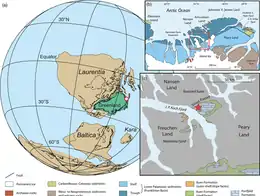
During the Cambrian, Greenland was located in the southern tropical to temperate region. The Buen Formation forms part of the southern shelf succession of the Franklinian Basin of North Greenland and the Canadian Arctic Islands. The formation, approximately 325 metres (1,066 ft) thick, consists of a lower, sand−dominated, member overlain by an upper member dominated by dark grey−green mudstones and siltstones in its type area in southern Peary Land. It thickens to around 700 metres (2,300 ft) in northern Peary Land where it comprises a mud−rich transitional succession into deep water trough deposits of the Polkorridoren Group. Dark grey to black mudstones form part of this transitional succession from the shelf to the slope. To the south they lie in faulted contact with pale dolomites of the underlying Portfjeld Formation, and to the north with bioturbated mudstones and sandstones of the Buen Formation.[4]
Fossil content
The following fossils have been reported from the formation:[1]
| Group | Taxon | Image | Notes |
|---|---|---|---|
| Annelids | Phragmochaeta canicularis | 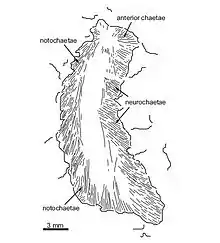 | [5] |
| Arthropods | Buenaspis forteyi | 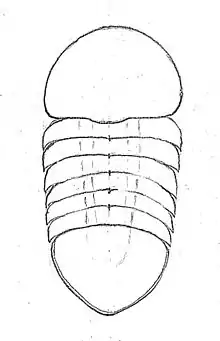 | [6] |
| Buenellus | 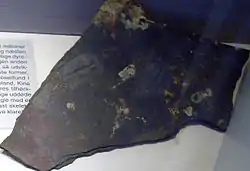 | [1] | |
| Aaveqaspis | 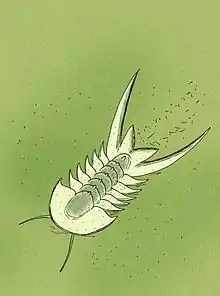 | ||
| Kerygmachela | 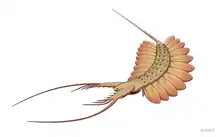 | ||
| Tamisiocaris |  | ||
| Limniphacos | |||
| Waptia | |||
| Kleptothule rasmusseni |  | [6] | |
| Isoxys volucris |  | ||
| Hadranax augustus | |||
| Pauloterminus spinodorsalis | |||
| Molluscs | Halkieria evangelista |  | |
| Demosponges | Choia hindei | ||
| Others | Heliosphaeridium dissimilare | ||
| Trapezovitus malinkyi | [1] | ||
| Kalaallitia myliuserichseni | |||
| Nasaaraqia hyptiotheciformis | |||
| Nevadotheca boerglumensis | |||
| Sullulika broenlundi | |||
| Alutella siku | [7] | ||
See also
| Wikimedia Commons has media related to Buen Formation. |
References
- Buen Formation at Fossilworks.org
- Geyer & Peel, 2011, p.466
- Higgins et al., 2000, p.141
- Conway Morris & Peel, 2008, p.138
- Conway Morris & Peel, 2008, p.144
- Sirius Passet, Buen Formation at Fossilworks.org
- Peel & Willman, 2018, p.381
Bibliography
- Peel, John S., and Sebastian Willman. 2018. The Buen Formation (Cambrian Series 2) biota of North Greenland. Papers in Palaeontology 4. 381–432. Accessed 2018-08-07.
- Geyer, Gerd, and John S. Peel. 2011. The Henson Gletscher Formation, North Greenland, and its bearing on the global Cambrian Series 2-Series 3 boundary. Bulletin of Geosciences 86. 465–534. Accessed 2018-08-07.
- Conway Morris, Simon, and John S. Peel. 2008. The earliest annelids: Lower Cambrian polychaetes from the Sirius Passet Lagerstätte, Peary Land, North Greenland. Acta Palaeontologica Polonica 53. 137–148. Accessed 2019-02-14.
 Material was copied from this source, which is available under a Creative Commons Attribution 4.0 International License.
Material was copied from this source, which is available under a Creative Commons Attribution 4.0 International License. - Higgins, A.K.; N.J. Soper, and A.G. Leslie. 2000. The Ellesmerian and Caledonian Orogenie Belts of Greenland. Polarforschung 68. 141–151. Accessed 2018-08-07.
Further reading
- A. C. Daley and J. S. Peel. 2010. A Possible Anomalocaridid from the Cambrian Sirius Passet Lagerstätte, North Greenland. Journal of Paleontology 84(2):352-355
- C. B. Skovsted and J. S. Peel. 2011. Hyolithellus in life position from the Lower Cambrian of north Greenland. Journal of Paleontology 85(1):37-47
- G. E. Budd and J. S. Peel. 1998. A new xenusiid lobopod from the Early Cambrian Sirius Passet fauna of North Greenland. Palaeontology 41(6):1201-1213
- J. K. Rigby. 1986. Cambrian and Silurian sponges from North Greenland. Rapport Groenlands Geologiske Undersoegelse 132:51-63
- M. Williams, D. J. Siveter, and J. S. Peel. 1996. Isoxys (arthropoda) from the Early Cambrian Sirius Passet Lagerstaette, North Greenland. Journal of Paleontology 70(6):947-954
- S. Conway Morris and J. S. Peel. 1990. Articulated halkieriids from the Lower Cambrian of north Greenland. Nature 345(28):802-805